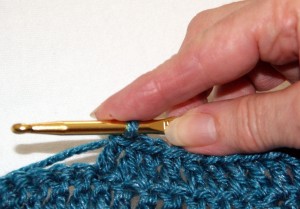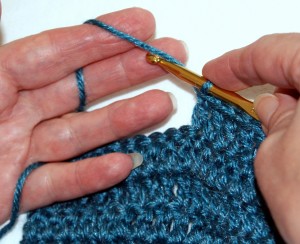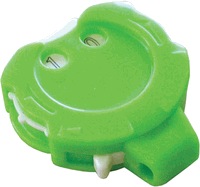I am always debating whether to block my finished crochet piece?? For me, it all depends upon the type of yarn I have used and what my completed project is — a doily or clothing or afghan.
It is very important to always read what the manufacturer of the yarn recommends when it comes to washing and/or dry cleaning suggestions. If using a cotton yarn/thread, I like to hand wash my completed project and lay if flat to dry. When it is almost dry but still slightly damp, I will place it onto my ironing board, cover it with a towel and then use the steam feature on my iron. Holding the iron very close to the towel without actually placing the iron on the item. This will give you a smooth finished look without stretching the yarn and eliminate any curling that might have occurred.
One concern with cotton yarn that I always seem to dwell upon is the question of shrinkage. I haven’t experienced any problems with shrinkage as long as I use cold water and air dry. Then block the piece as mentioned above.
When using a wool blend yarn, again follow the manufacturer’s washing/dry cleaning directions, and then, if needed, you can block the piece the same way as described above. A lot of times, however, when I have completed a project, I will lay it out flat on a padded surface, spray it lightly with water, and just pat it into shape and let air dry.
I find too that if I am crocheting a sweater, it is a little easier to block or shape your pieces as you crochet them. Again, laying them out on a padded surface, spray lightly with water and just pat them into their shape and air dry. Then everything is ready to be joined according to your pattern directions.
You will find there are those projects that really need to be a certain size when completed, i.e., socks, mittens, hats, some sweaters, and blocking your piece helps you to shape your work to those measurements. Most importantly, your crocheting GAUGE must be accurate too for the completed project to be the size you need. Blocking tools are available that you can put your damp project over to assist you in this shaping process.
My daughter and I are presently experimenting with blocking a rather large afghan that seems to curl on the edges. We are laying it out flat onto a carpeted area that we have laid several towels down first. Then we will be spritzing it with water, covering it with more large towels and then running a floor steamer over the top of everything. Again, not touching the project with the steamer itself, just shooting the steam through everything. Then we will take the top towels off, pat into shape and let air dry. We feel confident that this will work and will be much easier to shape since the afghan is a comforter size.
Always trying to keep those “creative juices” flowing!!
HAPPY CREATING!!
Disclaimer: This post contains affiliate links – “small commission earned”






